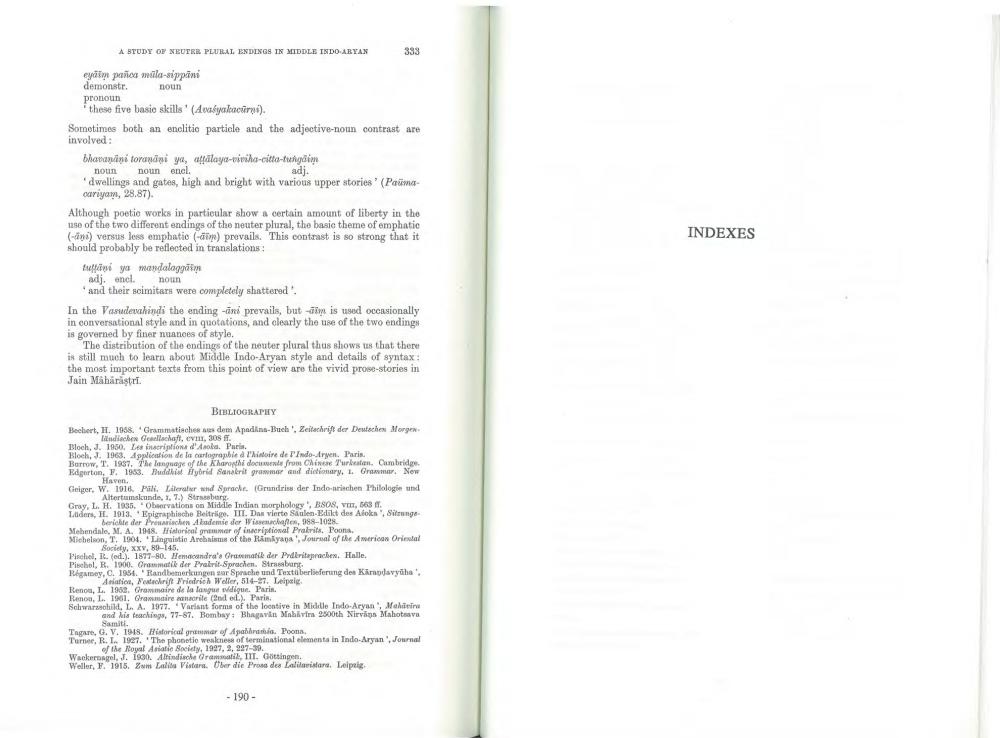________________
A STUDY OF NEUTRE PLURAL ENDINGS IN MIDDLE INDO ARYAN
eydin panca mala-sippani
demonstr.
noun
pronoun
these five basic skills' (Avasyakacuri).
Sometimes both an enclitic particle and the adjective-noun contrast are involved:
bhavanāni toraṇāņi ya, attalaya-viviha-citta-tungim
noun noun encl.
adj.
dwellings and gates, high and bright with various upper stories' (Paumacariyam, 28.87).
Although poetic works in particular show a certain amount of liberty in the use of the two different endings of the neuter plural, the basic theme of emphatic (-ai) versus less emphatic (-ai) prevails. This contrast is so strong that it should probably be reflected in translations:
tulani ya mandalaggam
adj. encl. noun
and their scimitars were completely shattered.
333
In the Vasudevahindi the ending -dni prevails, but aim is used occasionally in conversational style and in quotations, and clearly the use of the two endings is governed by finer nuances of style.
The distribution of the endings of the neuter plural thus shows us that there is still much to learn about Middle Indo-Aryan style and details of syntax: the most important texts from this point of view are the vivid prose-stories in Jain Maharăştri.
BIBLIOGRAPHY
Bechert, H. 1968. Grammatisches aus dem Apadina-Buch', Zeitschrift der Deutschen Morgen. ländischen Gesellschaft, ev, 308 ff.
Bloch, J. 1950, Les inscriptions d'Asola. Paris.
Bloch, J. 1963, Application de la cartographie à l'histoire de l'Indo-Aryen. Paris.
Barrow, T. 1937. The language of the Kharoghi documents from Chinese Turkestan. Cambridge. Edgerton, F. 1953. Buddhist Hybrid Sanskrit grammar and dictionary, 1. Grammar. New Haven.
Geiger, W. 1916. Pili, Literatur und Sprache. (Grundriss der Indo-arischen Philologie und Altertumskunde, 1, 7.) Strasburg.
Gray, L. H. 1935, Observations on Middle Indian morphology, BSOS, vm, 563 ff.
Lüders, H. 1913. Epigraphische Beiträge. III. Das vierte Säulen-Edikt des Aloka, Sitzunge berichte der Freuarischen Akademie der Wissenschaften, 988-1028 Mehendale, M. A. 1948. Historical grammar of inscriptional Prakrits. Poons. Michelson, T. 1904. Linguistic Archaisms of the Ramkyana', Journal of the American Oriental
Society, xxv, 89-145.
Pischel, R. (ed.). 1877-80. Hemacandra's Grasematik der Prakritsprachen. Halle.
1900. Grammatik der
Régamey, C. 1954. Randbemerkungen zur Sprache und Textuberlieferung des Kärandavyuha Asiatica, Festschrift Friedrich Weller, 514-27. Leipzig.
Renou, L. 1952. Grammaire de la langue vidique. Paris.
Renou, L. 1961. Grammaire sansorile (2nd ed.). Paris.
Schwarzschild, L. A. 1977. Variant forms of the locative in Middle Indo-Aryan, Mahavira and his teachings, 77-87. Bombay: Bhagavan Mahavira 2500th Nirvana Mahotsava Samiti.
Tagare, G. V. 1948. Historical grammar of Apabhrasia. Poona
Turner, R. I. 1927. The phonetic weakness of terminational elements in Indo-Aryan', Journal of the Royal Asiatic Society, 1927, 2, 227-39. Wackernagel, J. 1930. Altindische Grammatik, III. Gottingen.
Weller, F. 1915. Zum Lalita Vistara. Über die Prosa des Lalitaristara. Leipzig.
-190
INDEXES




